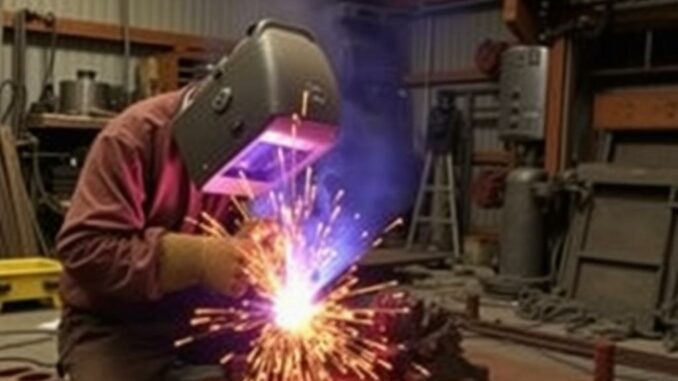
SQLITE NOT INSTALLED
Welding, the art and science of joining metals, has shaped the world in ways many of us may overlook. From towering skyscrapers to iconic ships, welding has been the backbone of countless engineering marvels throughout history. This article delves deep into some of the most famous welding projects ever undertaken, highlighting how this crucial technique brought visionary ideas to life. Whether you’re familiar with welding or just curious about how some of the world’s most incredible structures came to be, this comprehensive guide will engage, inform, and inspire.
What is Welding? A Brief Introduction

Before we jump into the most famous welding projects in history, let’s clarify what welding really is. Welding is a fabrication process that joins materials, usually metals or thermoplastics, by causing coalescence. This is typically done by melting the base metal and adding a filler material to form a strong joint once cooled. The entire process requires skill, precision, and knowledge about metal properties and heat control.
Welding isn’t just about sticking two pieces of metal together—it’s an intricate craft that ensures durability, strength, and safety in everything from small household items to massive infrastructure projects. Welders use various techniques such as arc welding, MIG (metal inert gas) welding, TIG (tungsten inert gas) welding, and gas welding, each with its specific applications and materials.
The Importance of Welding in Modern Engineering
Without welding, much of the modern world’s infrastructure wouldn’t exist as we know it today. Welding holds together bridges, airplanes, cars, ships, and even the deep space rovers exploring distant planets. It’s a skill that has allowed humans to push the boundaries of design and function.
In industries ranging from aerospace to construction, the ability to securely join metals has led to stronger, more efficient, and more reliable projects. The continuous improvement in welding technologies and techniques over the decades has enabled engineers to dream bigger and build taller, faster, and more durable.
The Most Famous Welding Projects in History
Now, with a solid understanding of welding’s role, let’s explore some of history’s most iconic welding projects. These projects have captivated imaginations worldwide, standing as testament to human ingenuity and the vital role of welding in engineering.
1. The Brooklyn Bridge
The Brooklyn Bridge, completed in 1883, is one of the oldest suspension bridges in the United States. Although welding was not as advanced during this period as it is today, its modifications, repairs, and maintenance over the decades have relied heavily on welding. The bridge represents how welding integrates with historic engineering feats to ensure longevity.
The bridge spans the East River, connecting Manhattan and Brooklyn, and is a marvel of design, featuring its iconic Gothic arches. While riveting was the primary technique during its initial construction, welding has been critical in the extensive restorations, allowing workers to keep the structure safe and functional.
2. The Empire State Building
The Empire State Building, constructed during the Great Depression and completed in 1931, is a shining example of welding’s contribution to skyscraper construction. Welding was instrumental in assembling its steel framework efficiently and securely, enabling the rapid pace of construction famously completed in just over a year.
The building’s steel skeleton required thousands of welds to hold its towering form, demonstrating how welding can transform raw materials into towering symbols of human achievement. It stands as a reminder of how welding technology helped define the 20th century’s urban landscapes.
3. The Hoover Dam
Completed in 1936, the Hoover Dam is a monumental hydroelectric project that reshaped the American West by controlling water flow and generating electricity. Welding was instrumental in various components, including the steel framework, pipelines, and penstocks that channel water through turbines.
This project not only required large-scale welding techniques but also involved innovative approaches to handle the intense heat and pressure conditions involved. The dam symbolizes how welding created infrastructure that supports millions and fosters economic growth.
4. The Golden Gate Bridge
Another American engineering icon, the Golden Gate Bridge, completed in 1937, is renowned for its stunning Art Deco design and bright orange color. Welding played a significant role in assembling the steel sections of the massive suspension cables and tower components.
The bridge spans the San Francisco Bay, and its construction demanded precision welding to maintain structural integrity against the harsh marine environment and strong winds. Today, ongoing maintenance welding ensures the bridge remains safe for millions of travelers annually.
5. The RMS Queen Mary
One of the most famous ocean liners, the RMS Queen Mary was built in the 1930s and exemplifies welding’s critical role in shipbuilding. Welding allowed for stronger, lighter hulls compared to traditional riveting, contributing to greater speed and durability on the high seas.
The Queen Mary’s construction marked a turning point in maritime history, with welded joints enabling longer voyages and increased safety. The ship now serves as a floating museum, celebrating both its history and the evolution of welding in shipbuilding.
6. The Boeing 747
The Boeing 747, affectionately known as the “Jumbo Jet,” revolutionized air travel when it first took to the skies in 1969. Welding was fundamental in assembling its aluminum fuselage and wings, ensuring the aircraft’s robustness under high stress.
Aircraft welding demands exceptional precision because any flaws could have catastrophic consequences. The success of the 747 demonstrated welding’s vital role in aerospace engineering, enabling safer, larger, and more fuel-efficient airplanes to take flight.
7. The International Space Station (ISS)
The International Space Station, orbiting Earth since 1998, is arguably one of the most extraordinary welding projects in human history. While much of the welding was done on Earth before launch, robotic welding techniques have been developed for potential future space fabrication.
Welding technology is key to constructing durable modules that withstand the extreme conditions of space. The ISS exemplifies how welding has expanded beyond our planet, supporting humanity’s quest for exploration and scientific advancement.
Understanding Welding Techniques Used in Famous Projects
The famous welding projects mentioned above incorporated various welding techniques depending on the requirements of materials, scale, and environmental factors. Below is a table outlining some common welding methods and their applications in these landmark projects:
| Welding Technique | Description | Famous Projects Using This Technique |
|---|---|---|
| Arc Welding | Uses an electric arc to melt metals. Common for structural steel. | Empire State Building, Golden Gate Bridge |
| MIG Welding (Metal Inert Gas) | Continuous solid wire electrode fed through a welding gun. | Boeing 747, RMS Queen Mary |
| TIG Welding (Tungsten Inert Gas) | Provides precision welding using a tungsten electrode. | International Space Station components |
| Gas Welding | Uses a flame fueled by gas for melting metals. | Brooklyn Bridge repairs, early shipbuilding |
The Evolution of Welding Technology
Welding technology has evolved dramatically from the early 19th century when simple forging and brazing techniques laid the groundwork. The advent of electric arc welding in the late 1800s revolutionized the industry, enabling stronger joins and faster construction times.
Post-World War II saw massive advancements, with automated and robotic welding systems emerging to meet growing industrial demands. These innovations are reflected in the construction of modern skyscrapers, aircraft, and naval vessels.
Famous Welders Who Made History

Behind every great welding project are skilled professionals whose expertise ensured safety, strength, and reliability. Here are a few notable welders and engineers whose contributions stand out in welding history:
- Owen C. H. Clarke: Often called the “father of arc welding,” Clarke developed early arc welding techniques that transformed modern manufacturing.
- Francis E. Houdaille: Pioneered submerged arc welding, improving weld quality and speed during shipbuilding in the mid-20th century.
- James F. Lincoln: Founded one of the first companies specializing in welding equipment, advancing welding technology and education.
These individuals and many others laid the foundation for the welding practices used in world-famous projects.
Challenges Faced in Famous Welding Projects
Every iconic welding project had its share of challenges, testing the skill and innovation of the crews involved. For example, welding in the construction of the Hoover Dam required managing extreme heat and concrete curing times, while building the Boeing 747 demanded precise control to meet stringent aerospace standards.
Environmental factors like humidity, temperature, and corrosion also impact weld quality, particularly in marine settings like the Golden Gate Bridge or RMS Queen Mary. Advances in protective coatings and specialized welding rods address these challenges.
The Future of Welding: Innovations and Trends

The story of welding continues to unfold with exciting innovations on the horizon. Here are some trends shaping the future:
- Robotic and Automated Welding: Robots now perform repetitive, hazardous welding tasks with unmatched precision and speed.
- Laser Welding: High-energy laser beams allow finer control and faster operation, beneficial for aerospace and electronics.
- Additive Manufacturing (3D Metal Printing): Combining welding and 3D printing processes to create complex metal parts with minimal waste.
- Underwater Welding Advances: Essential for underwater infrastructure inspections and repairs in offshore industries.
These advancements promise to make welding safer, more efficient, and capable of tackling even grander projects.
Summary: Why Welding Matters in History and Beyond
Welding has been instrumental in creating some of history’s most celebrated engineering achievements. Its ability to securely join metals has allowed humanity to form incredible buildings, vast bridges, dynamic aircraft, and even space stations. Each famous welding project tells a story of collaboration between metal, fire, and expert hands.
As we look to the future, the innovations shaping welding promise to keep fueling human progress. Whether you’re a student, engineer, or history enthusiast, understanding welding’s crucial role enriches your appreciation of the physical world designed and built around us.
From the Brooklyn Bridge to the International Space Station, welding remains the invisible but essential craft that holds together the dreams we dare to build.
Further Reading and Resources
- American Welding Society (AWS) – A leading resource for welding education and standards.
- History of Welding in the Industrial Revolution – Learn about the origins of modern welding techniques.
- NASA’s Welding Innovations – Insights into welding technology used in space exploration.
- Boeing’s Manufacturing Process – Overview of welding in aerospace manufacturing.
Whether you’re fascinated by history, technology, or engineering, these resources offer in-depth knowledge to explore the art and science of welding even further.
